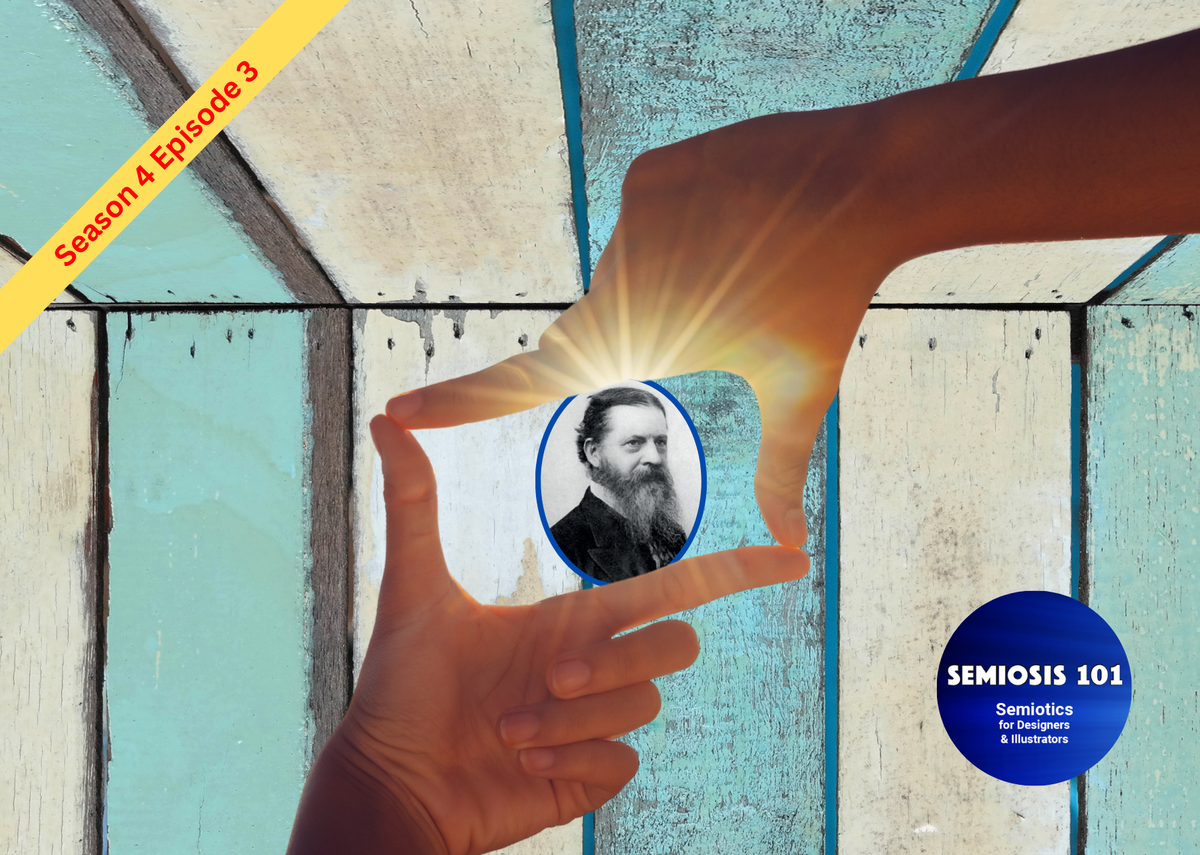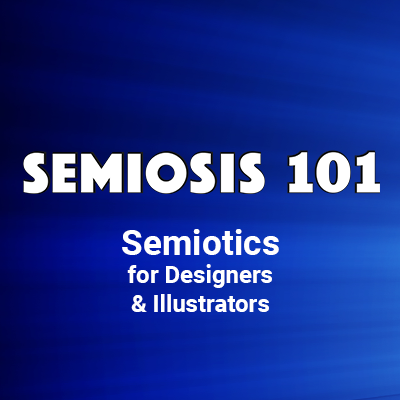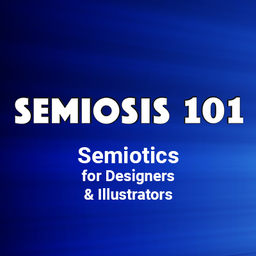Free Semiosis 101 Transcript 4.3:

How CAN CREATIVES MAKE a Small Perspective Change Advantageous?
Hello readers.
In this free transcript for the episode 4.3 published on Semiosis 101 on Weds 2nd April 2025, we are taking a semantic turn in how I explain Peirce’s semiotic sign-action to you designers and illustrators. We will make small tweaks in your own perception on how you semiotically ideate. Your existing creative mindset can be augmented and enhanced with a framework of Semiosis to utilise many levels for visually encoding meaning. In this episode you’ll begin to see why and how.
Watch the free episode on YouTube for the full impact…
…and here is the episode’s transcript.
How CAN CREATIVES MAKE a Small Perspective Change Advantageous?
You illustrators and designers will be surprised by how a small change in your thinking opens up semiotics to you. Once you realise that semiotic signs are not tangible SIGNAGE, then you will design and/or illustrate with a fresh visual communication perspective.
Let us now explore how audience perception helps you to utilise many levels for visually encoding meaning. Perception leads to interpretation, which leads to understanding. So in our 3rd episode of Semiosis 101’s season four, we will make small tweaks in your own perception on how you semiotically ideate.
Semiosis 101 is also taking a semantic turn in how I explain Peirce’s semiotic sign-action to designers and illustrators. It is not enough to develop and sketch potential ideas to answer a client’s brief, without considering effective visual meaning-bearing.
In his 2005 design book The Semantic Turn, Klaus Krippendorff describes meaning and perception succinctly (p52).
Meaning
“On a most basic level, meaning restores perceived differences between what is sensed and what seems to be happening.”
Perception
“Meaning arises in the awareness of the possibility of different ways of seeing.”
Understanding our audience’s perceptions is crucial in semiotically crafting effective visual communication. For our audience to perceive the intended meanings visually communicated in our work, we need to semiotically facilitate this. In terms of applied semiotic sign-action, we craft our visual language from familiar qualities, which possibly could indicate aspects of THIS*
(insert whatever you need *here).
It is our audience, as interpreters of meaning, who will deem what is familiar, to possibly indicate something more complex. Let me give a quick and broad cultural example.
Whiteness is a quality. In Western cultures we can interpret WHITE as indicating purity (amongst other things). In Eastern cultures WHITE is perceived to be a colour for mourning. It still remains WHITE. Audience’s learn that one quality can be X while others it could mean Z. Culturally, our audience’s lived experiences (lifeworlds) can be very helpful to you creatives.
Lifeworlds is a phenomenological term, and Peirce’s Semiosis is structured within a phenomenological understanding of human perceptions. Peirce’s semiotic sign-action is predicated on the phenomena of interpreting meaning from our crafted representations. We call these encoded semiotic signs.
The small perspective change you creatives are making right now, is in the realisation that, beyond any design or illustration aesthetic, you hold semiotic power in your creative hands. You may decide to design or illustrate A, B or C because you personally like that. However, as creatives you are ALWAYS creating outcomes for OTHER people. Not yourself. Other people have experiences and references they draw on.
In the last episode, I asked how would you represent a DOG if the audience has never experienced a DOG.Let us now semiotically explore how. Okay, I am labouring the idea of DOG here for obvious reasons. You can substitute DOG for anything you wish. The following argument and explanation will remain relevant.
Our audience has no experience of an existential thing as a DOG. So there is no point in focussing your efforts in visualising a vast array of breeds to the audience. They will not understand. What in their lived experiences will help them to gain knowledge of DOG?What qualities does a DOG have that our audience are familiar with? We can semiotically use these to facilitate their understanding towards interpreting DOG.
A DOG has a head, a body, four legs and a tail. These qualities, in a familiar configuration, can trigger our audience’s perception. They can interpret the shape as a possible animal of some sort. We are semiotically mediating audience interpretations to the concept we are visually communicating.
If the audience can only perceive a pattern of qualities (we interpret DOG, but they do not), then something is still being communicated. They can still be mediated to interpret a lesser meaning of, maybe, “animal” or “mammal” or “beast.”
From our selection of qualities known to our audience e.g. a leg shape, a head shape, etc. we help our audience to instantly perceive things that are already familiar to them. We mediate our audience to suggest further meaning which they can confidently interpret. A DOG is an animal, but it will semiotically take another Final step, to learn a new thing such as a DOG.
But we are human. We learn new things all the time. Semiosis is built on perception to work.
Creatives focus on the representation of the concept, that is what you illustrate or design. You use various elements to construct a visual language to convey meaning. You visually communicate something to someone. This is what you do, and what you have always done as designers and illustrators. If we want to, we can describe this as the Signifier | Signified from Saussure’s Semiology. What is visualised is indicating what is meant.
In Semiosis, this is only two-thirds of Pragmatic semiotic sign-action. Your audience contributes to the final third of Semiosis’ power. What they perceive and interpret is a direct result of what the creative has created, AND what the audience already has experience of.
To facilitate a target audience to understand what they see, the creative semiotically helps the audience to form their interpretations. The phenomenon of human perception is subconscious. Peirce describes three phenomenological states in which the audience, creative and Semiosis builds meaning within: the states of Firstness, Secondness and Thirdness.
These three states help to structure how semiotic sign-action grows in power, from weak semiotic qualities to visually communicate more complex meaning. Check out the YouTube playlists for more on these states and ten semiotic sign classes. Or visit the Semiosis 101 Semiotic Resource on Semiosis101.online if you want to read more. Links are below in the description.
With the perception and the lived experiences of our target audience, interpretation of the representation of the concept can be made. But is it visually communicating what is intended? Again, Peirce’s Semiosis offers frameworks to support the crafting of the creative’s aesthetic, to connect with the audience.
A simple mark or a brush stroke to one person may suggest one thing, while another person may not “get it.” A brush stroke could suggest a tree, hair, the wind, texture, etc. This depends on the audience. After all it is just a brush stroke …a mark. How can a simple mark suggest all of those things to someone? In the context the brush stroke or mark is seen in, it shares familiar but weak qualities with something known to the audience.
If the mark puts in the mind of the audience any of the suggested things, it is because the audience makes a weak connection based on their experience of things. Now jumping to a well-known swoosh shape, the audience can agree that that shape now means Nike. How did interpretation jump so abruptly?
I have just summed up the simple to complex power of Semiosis …with just shapes. The advantageous shift in a creative’s mindset is when you realise that a simple mark, stroke, shape, etc. is a semiotic building block. Meaning is embodied and emerges from the interface between representation and interpretation. This facilitates audience perception to the intended concept.
The small perspective change you can make comes from this pragmatic experiential take on visually communicating. An applied framework of Semiosis can augment and enhance any creatives’ tacit mindset, to effectively improve visual communication.
Peirce’s philosophy offers you creatives a practical way to apply semiotics. But as his writing is obtuse it is not immediately clear how to. This is why Semiosis 101 exists. So let us conclude on which perspective change you creatives can make today. Peirce’s writes quite obtusely on Qualisign-this, Representamen-that, and about states of Firstness, Secondness and Thirdness. However, his triadic structure IS BENEFICIAL to you.
At a macro scale, you creatives are happy with the triad of client > creative > audience. At a semiotic micro scale the concept > representation > interpretation determination flow is the power. Semiosis does not go around the triad once and ends. Semiosis, once triggered is perpetual. A successful interpretation brings the audience to the intended concept. Then the semiotic determination flow goes around again. This is how weak qualities lead to complex semiotic meaning.
Subscribe to Semiosis 101 to be notified when the next episode on this is published. Semiosis 101 Producers on Patreon can watch all episodes months ahead of YouTube …plus other exclusive content and a Semiosis 101 Publisher credit.
Hint… hint…
Semiosis 101 Semiotic Design Resources is a reader-supported publication. To receive exclusive posts and support my work, consider becoming a free or paid subscriber. Paid subscribers get name checked on all future Semiosis 101 YouTube episodes.
===Semiosis 101 Patreon Producer==============
Become a Semiosis 101 Patreon Producer and get a named producer credit on future video episodes, plus watch all new episodes months ahead of YouTube.
===Semiosis 101 Patreon Exclusives==============
Watch longer Patreon-exclusive Semiosis 101 episodes on applying Semiosis into design and illustration…
PATEXC001 How does semiotics work in illustration?





